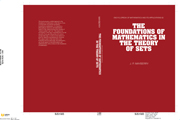Appendix 1 - Conceptual Notation
Published online by Cambridge University Press: 05 March 2012
Summary
Setting up a conceptual notation
I shall now set up a conceptual notation analogous to Frege's Begriffs-schrift. To simplify my presentation, I shall conform to the customary conventions of exposition that mathematical logicians have come to employ in such matters, speaking of symbols, terms, formulas, etc., as if they were actually written down. In particular I shall speak of expressions as strings of primitive signs, and strings of expressions separated by commas as lists of expressions; the expressions that comprise such a list I shall call its items or terms.
The most convenient formulation for our conceptual notation is as a sequent calculus in the style of Gentzen. I have already laid down2 the definitions of term and formula, which comprise the well-formed expressions of our conceptual notation.
Amongst formulas we must distinguish between global formulas, which contain global (unbounded) quantifiers, and local formulas, which do not. In the basic conceptual notation I shall require that a global quantifier of either type can occur only in the prefixes of prenex formulas, all other quantifiers in which (if any) are of the same sort. All formulas in the basic conceptual notation are thus either quantifier free, Π1, or Σ1. This notation is sufficient to express the propositions I have employed in the body of the text, but there is theoretical interest in considering a wider class of formulas. I shall return to this in the next section.
Information
- Type
- Chapter
- Information
- The Foundations of Mathematics in the Theory of Sets , pp. 396 - 410Publisher: Cambridge University PressPrint publication year: 2001
